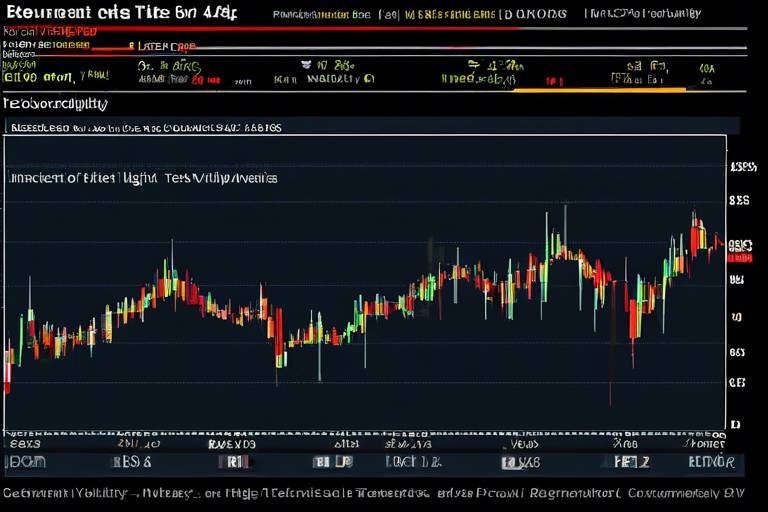The Benefits of Multi-Indicator Strategies in Crypto Trading
In the fast-paced world of cryptocurrency trading, making informed decisions is crucial for success. With the market's notorious volatility, relying on a single indicator can lead to missed opportunities or, worse, significant losses. This is where multi-indicator strategies come into play. By combining various technical indicators, traders can create a more robust framework for analyzing market conditions and executing trades. Think of it as having multiple lenses through which to view the complex landscape of crypto assets, allowing for a clearer and more comprehensive understanding of potential price movements.
Multi-indicator strategies not only enhance decision-making but also provide a safety net against the inherent risks of trading cryptocurrencies. By integrating different indicators, traders can filter out noise and focus on what truly matters—identifying trends and making timely trades. This method fosters a more disciplined approach, reducing emotional trading and improving overall performance. So, if you’re looking to elevate your trading game, embracing a multi-indicator strategy might just be the key to unlocking your potential in the crypto market.
At its core, a multi-indicator strategy involves the use of multiple technical indicators to inform trading decisions. Each indicator provides unique insights, and when combined, they create a more holistic view of market dynamics. For instance, a trader might use moving averages to identify trends, alongside Relative Strength Index (RSI) to gauge momentum and volatility. By synthesizing these indicators, traders can better understand when to enter or exit positions.
Imagine trying to solve a puzzle with only a few pieces; it’s challenging and often leads to an incomplete picture. However, with a multi-indicator approach, you’re essentially gathering more pieces of the puzzle, allowing for a clearer and more accurate representation of the market landscape.
Utilizing multiple indicators can significantly enhance the decision-making process for traders. Instead of relying on a single signal, which can sometimes be misleading, traders can cross-reference data from various sources. This cross-verification helps to confirm trends and signals, leading to more informed and confident trading decisions.
Effective risk management is paramount in the unpredictable world of crypto trading. Multi-indicator strategies play a vital role in identifying potential risks, allowing traders to set appropriate stop-loss levels. This proactive approach protects investments and minimizes losses, which is essential for long-term success.
Incorporating multiple indicators into your trading strategy aids in determining optimal stop-loss levels. By analyzing various signals, traders can set stop-loss orders that are better aligned with market conditions, thus reducing potential losses. This disciplined approach is especially important in volatile markets where prices can swing dramatically in a short period.
Another significant advantage of multi-indicator strategies is the ability to identify prevailing market trends more effectively. By analyzing a combination of indicators, traders can pinpoint strategic entry and exit points, maximizing profit potential while minimizing risks. For example, if both the moving average and RSI indicate a bullish trend, it strengthens the case for entering a long position.
Multi-indicator strategies can significantly enhance existing trading strategies. By integrating different indicators, traders can refine their approaches and adapt to changing market conditions more effectively. This adaptability is crucial as the crypto landscape is constantly evolving, and what worked yesterday may not work today.
Backtesting multi-indicator strategies is an essential step for traders looking to assess their effectiveness over historical data. This process allows traders to see how their strategies would have performed in various market conditions, providing valuable insights for optimization. By analyzing historical performance, traders can adjust their strategies to ensure they are robust and reliable before implementing them in live trading.
During the backtesting phase, it’s crucial to analyze performance metrics to gain insights into the strengths and weaknesses of a strategy. Key metrics such as win rate, risk-reward ratio, and drawdown are vital in understanding a strategy's viability. This evaluation is essential for continuous improvement and achieving long-term trading success.
Market conditions can change rapidly, and multi-indicator strategies allow traders to adjust their tactics accordingly. This adaptability is key to maintaining profitability in the ever-evolving cryptocurrency landscape. By regularly reviewing and tweaking their strategies based on indicator signals, traders can stay ahead of the curve and respond effectively to market shifts.
- What are the most common indicators used in multi-indicator strategies? Popular indicators include Moving Averages, RSI, MACD, and Bollinger Bands.
- How do I choose the right indicators for my strategy? It’s best to select indicators that complement each other and provide insights into different aspects of market behavior.
- Can multi-indicator strategies guarantee profits? While they can improve decision-making and risk management, no strategy can guarantee profits due to the unpredictable nature of the crypto market.
- How often should I backtest my strategies? Regular backtesting is recommended, especially after significant market changes or when adjusting your strategy.

Understanding Multi-Indicator Strategies
When diving into the world of cryptocurrency trading, one quickly realizes that the market is a wild beast, often unpredictable and full of surprises. This is where multi-indicator strategies come into play, acting like a compass for traders navigating through this chaotic landscape. But what exactly does this mean? In simple terms, multi-indicator strategies involve the use of several technical indicators simultaneously to make trading decisions. Think of it as assembling a toolkit; each tool serves a specific purpose, and together they provide a more comprehensive understanding of the market.
By employing a variety of indicators, traders can gather insights from different angles, creating a well-rounded perspective on potential price movements. For instance, while one indicator might suggest a bullish trend, another could hint at an impending reversal. This synergy helps traders avoid falling into the trap of relying solely on a single indicator, which can sometimes lead to misleading signals. Imagine trying to navigate a stormy sea with just one oar; it’s challenging and risky. However, with multiple oars (or indicators), you can steer your ship more effectively.
Some common indicators that traders often combine include:
- Moving Averages: These help smooth out price data to identify trends over a specific period.
- Relative Strength Index (RSI): This momentum oscillator measures the speed and change of price movements, indicating overbought or oversold conditions.
- Bollinger Bands: These provide a visual representation of volatility and potential price levels.
- MACD (Moving Average Convergence Divergence): This indicator helps identify potential buy and sell signals through the relationship between two moving averages.
When these indicators are used together, they can paint a clearer picture of market conditions. For example, if the RSI indicates an asset is oversold while the moving average shows a bullish crossover, this could signal a potential buying opportunity. By integrating various indicators, traders can create a more robust strategy that enhances their chances of success.
Moreover, the beauty of multi-indicator strategies lies in their flexibility. Traders can customize their approach based on their individual trading style and risk tolerance. Whether you’re a day trader looking for quick profits or a long-term investor aiming for steady growth, combining different indicators allows for a tailored strategy that can adapt to your needs.
In summary, understanding multi-indicator strategies is akin to learning a new language in the crypto trading world. It equips traders with the tools necessary to make informed decisions, manage risks effectively, and ultimately, navigate the volatile waters of cryptocurrency with confidence.

Improved Decision-Making
When it comes to cryptocurrency trading, the stakes are high and the market can be as unpredictable as a roller coaster. This is where multi-indicator strategies shine, offering traders a way to enhance their decision-making processes. By utilizing a combination of different technical indicators, traders can gain a much clearer picture of the market landscape. Imagine trying to navigate through a foggy forest with only a single flashlight; it’s tough, right? Now, think of how much easier it would be if you had multiple light sources illuminating different paths. That’s exactly what multi-indicator strategies do for traders—they light up the dark corners of the market.
Relying on just one indicator can be like putting all your eggs in one basket. While one indicator might suggest a buying opportunity, another might scream “danger!” The beauty of employing multiple indicators is that they can either confirm or contradict each other, providing a more balanced view. For instance, a trader might use a combination of moving averages, Relative Strength Index (RSI), and MACD (Moving Average Convergence Divergence) to gauge market momentum. If all three indicators align, it’s like receiving a green light from traffic signals, giving the trader more confidence to make a move.
Moreover, using multiple indicators can significantly reduce the chances of falling for false signals. In the fast-paced world of crypto trading, misleading information can lead to hasty decisions that result in losses. By cross-referencing data from various indicators, traders can filter out noise and focus on what truly matters. This multi-faceted approach not only enhances accuracy but also empowers traders to act more decisively. The result? A more structured decision-making process that can adapt to the ever-changing market dynamics.
It’s also essential to recognize that not all indicators are created equal. Some might work better in trending markets, while others excel in sideways or volatile conditions. By incorporating a diverse set of indicators, traders can tweak their strategies based on current market conditions. For example, during a bullish trend, a trader might lean more heavily on momentum indicators, while in a bearish market, they might prioritize trend-following indicators. This flexibility is crucial in a market known for its rapid shifts.
To sum it up, embracing a multi-indicator strategy is like having a well-rounded toolbox at your disposal. Each tool serves a unique purpose and, when used together, they create a robust framework for making informed trading decisions. With improved decision-making at the forefront, traders can navigate the cryptocurrency landscape with greater confidence and precision.

Risk Management Techniques
In the unpredictable world of cryptocurrency trading, effective risk management is not just a luxury—it's a necessity. Traders often find themselves navigating a sea of volatility, where prices can swing dramatically within minutes. This is where multi-indicator strategies come into play, offering a lifeline to those willing to embrace a more sophisticated approach. By integrating various indicators, traders can pinpoint potential risks with greater accuracy, allowing them to make informed decisions that protect their investments.
One of the most effective risk management techniques involves the use of stop-loss orders. These are predetermined price levels at which a trader will exit a position to prevent further losses. By incorporating multiple indicators, traders can determine the optimal stop-loss levels, which minimizes potential losses and fosters a disciplined approach to trading. Imagine sailing through stormy seas; having a reliable compass (your indicators) can help you steer clear of treacherous waters.
Furthermore, identifying market trends is another critical aspect of risk management. By analyzing various indicators, traders gain insights into the prevailing market conditions. This knowledge enables them to make strategic decisions regarding entry and exit points. For instance, if multiple indicators signal a downward trend, a trader can choose to exit their position early, thus safeguarding their capital. In this way, multi-indicator strategies not only enhance decision-making but also act as a shield against the unpredictable nature of the crypto market.
To illustrate the effectiveness of these techniques, consider the following table that outlines common risk management practices alongside their benefits:
| Risk Management Technique | Benefits |
|---|---|
| Stop-Loss Orders | Limits potential losses and helps maintain discipline. |
| Diversification | Spreads risk across multiple assets, reducing exposure to a single point of failure. |
| Position Sizing | Determines how much capital to allocate to each trade, balancing risk and reward. |
| Regular Review | Ensures strategies remain effective and adapt to changing market conditions. |
As you can see, employing these risk management techniques can significantly enhance a trader's ability to navigate the volatile waters of cryptocurrency trading. By utilizing multi-indicator strategies, traders not only improve their decision-making but also create a robust framework that protects their investments against unforeseen market fluctuations.
- What are multi-indicator strategies?
Multi-indicator strategies involve using multiple technical indicators to analyze market trends and make informed trading decisions. - Why is risk management important in crypto trading?
Risk management is crucial in crypto trading due to the market's inherent volatility, helping traders protect their investments from significant losses. - How can stop-loss orders help in trading?
Stop-loss orders automatically sell a security when it reaches a certain price, limiting potential losses and enforcing discipline in trading. - Can multi-indicator strategies adapt to changing market conditions?
Yes, multi-indicator strategies allow traders to adjust their tactics based on various market signals, enhancing their ability to remain profitable.

Setting Stop-Loss Orders
Setting stop-loss orders is a fundamental aspect of successful trading, especially in the unpredictable world of cryptocurrency. Imagine you’re driving a car on a winding road. Without proper brakes, you risk crashing at every turn. Similarly, in trading, stop-loss orders act as your safety brakes, preventing significant losses when the market takes an unexpected downturn. By defining a specific price point at which your position will automatically close, you can safeguard your investments against the wild fluctuations that are all too common in crypto markets.
When you incorporate multiple indicators into your strategy, determining the optimal stop-loss level becomes a more nuanced process. For instance, if a trader is using both the Moving Average Convergence Divergence (MACD) and the Relative Strength Index (RSI), they can analyze the signals provided by these indicators to set a stop-loss that is both strategic and informed. This way, instead of setting a stop-loss at a fixed percentage, you’re allowing market data to guide your decision, which can lead to more favorable outcomes.
Here’s how you can effectively set stop-loss orders using multi-indicator strategies:
- Analyze Market Conditions: Understand the current market trends and volatility. If the market is particularly choppy, you might want to set a wider stop-loss to avoid being prematurely stopped out.
- Use Support and Resistance Levels: Identify key support and resistance levels through various indicators. Placing your stop-loss just below a support level can provide a buffer against normal price fluctuations.
- Adjust for Volatility: Use indicators like the Average True Range (ATR) to gauge market volatility. A higher ATR suggests that you may need to set a wider stop-loss to accommodate larger price swings.
By following these guidelines, traders can create a more robust stop-loss strategy that not only protects their capital but also aligns with their overall trading plan. Remember, the goal is to maintain a disciplined approach while being responsive to market changes. This strategy not only minimizes potential losses but also instills a sense of confidence in your trading decisions.
Q1: What is a stop-loss order?
A stop-loss order is a pre-defined price at which a trader's position will automatically close to prevent further losses. It acts as a safety net in volatile markets.
Q2: How do I determine the best stop-loss level?
The best stop-loss level can be determined by analyzing market trends, support and resistance levels, and incorporating various technical indicators to guide your decision.
Q3: Can I adjust my stop-loss order?
Yes, you can adjust your stop-loss order as market conditions change. It's essential to remain flexible and adapt your strategy based on real-time market data.
Q4: Is it possible to set a trailing stop-loss?
Absolutely! A trailing stop-loss moves with the market price, allowing you to lock in profits while still providing a buffer against potential losses.

Identifying Market Trends
Identifying market trends is like being a detective in the wild world of cryptocurrency. When you combine various indicators, you equip yourself with the tools needed to decode the market's secret language. Think of it as having a treasure map that guides you to potential profit while steering you away from pitfalls. By analyzing indicators such as moving averages, Relative Strength Index (RSI), and Bollinger Bands, traders can paint a clearer picture of the market's direction.
For instance, moving averages can help smooth out price fluctuations, allowing traders to see the broader trend without getting lost in the noise of daily price changes. When the short-term moving average crosses above the long-term moving average, it often signals a bullish trend, while the opposite indicates a bearish trend. This crossover can act as a beacon, guiding traders on when to enter or exit positions.
But that's not all! The RSI can provide insights into whether a cryptocurrency is overbought or oversold. A high RSI (above 70) might suggest that a coin is due for a correction, while a low RSI (below 30) could indicate a buying opportunity. By integrating the RSI with moving averages, traders can validate their decisions, making their strategies even more robust.
Furthermore, Bollinger Bands add another layer of analysis by showing price volatility. When the bands contract, it signals a period of low volatility, often followed by significant price movement. This contraction can alert traders to prepare for upcoming opportunities, whether bullish or bearish. The combination of these indicators can enhance your market trend identification, leading to more strategic trading decisions.
In summary, identifying market trends through the lens of multi-indicator strategies is not just about spotting the obvious price movements; it’s about understanding the underlying forces at play. By leveraging these tools, traders can make informed decisions that align with market dynamics, ultimately improving their chances of success in this unpredictable landscape.
- What are multi-indicator strategies?
Multi-indicator strategies involve using various technical indicators to enhance trading decisions, providing a more comprehensive view of market trends. - Why is risk management important in crypto trading?
Effective risk management helps traders protect their investments and minimize losses, especially in the volatile cryptocurrency market. - How can backtesting improve trading strategies?
Backtesting allows traders to assess the effectiveness of their strategies using historical data, enabling optimization before live trading. - What indicators are commonly used in multi-indicator strategies?
Common indicators include moving averages, RSI, and Bollinger Bands, among others, each providing unique insights into market conditions.

Enhancing Trading Strategies
In the fast-paced world of cryptocurrency trading, is essential for staying ahead of the competition. By employing multi-indicator strategies, traders can significantly refine their existing approaches. Think of it as upgrading from a bicycle to a high-speed motorcycle; the right tools can propel you forward at an astonishing rate. Using a combination of indicators not only provides a more nuanced understanding of market dynamics but also equips traders with the ability to pivot quickly when conditions change.
Imagine you're navigating a stormy sea. Relying on just one compass may leave you disoriented, but having multiple navigation tools allows you to chart a clearer course. Similarly, multi-indicator strategies help traders synthesize various data points, leading to more informed decisions. For instance, combining trend indicators like Moving Averages with momentum indicators such as the Relative Strength Index (RSI) can offer a more comprehensive view of market conditions. This synergy helps traders identify optimal entry and exit points, maximizing profit potential while minimizing risks.
But how do you go about integrating these indicators effectively? It’s not just about slapping together a bunch of tools and hoping for the best. A well-thought-out strategy involves:
- Choosing the Right Indicators: Not all indicators are created equal. Selecting those that complement each other can create a powerful toolkit.
- Testing Combinations: Experiment with different combinations to see which ones yield the best results in various market conditions.
- Continuous Learning: The crypto market is ever-evolving, and so should your strategies. Stay updated with market trends and adjust your indicators accordingly.
In addition to improving decision-making, multi-indicator strategies also foster a disciplined approach to trading. For example, if one indicator signals a buy but another suggests caution, traders can adopt a more measured approach rather than diving headfirst into a trade. This balance not only supports better risk management but also encourages traders to think critically about their decisions.
Moreover, the beauty of multi-indicator strategies lies in their adaptability. As market conditions fluctuate, traders can adjust their indicators to reflect the current landscape. This flexibility is crucial for maintaining profitability in the unpredictable cryptocurrency market. By continually refining their strategies, traders can ensure they are not just reacting to market changes but are proactively positioning themselves for success.
In conclusion, enhancing trading strategies through multi-indicator approaches is akin to fine-tuning a musical instrument. Just as a well-tuned guitar produces harmonious sounds, a well-structured trading strategy can lead to more consistent results. By integrating various indicators, traders can navigate the complexities of the crypto market with greater confidence and precision.
Q1: What are multi-indicator strategies?
Multi-indicator strategies involve using multiple technical indicators to make more informed trading decisions in the cryptocurrency market. This approach provides a more comprehensive view of market trends and potential price movements.
Q2: How do multi-indicator strategies improve decision-making?
By relying on various indicators, traders can reduce the chance of being misled by a single indicator. This enhanced accuracy leads to better trading decisions and improved overall performance.
Q3: Can multi-indicator strategies help with risk management?
Absolutely! Multi-indicator strategies enable traders to identify potential risks more accurately, allowing them to set appropriate stop-loss levels and better protect their investments.
Q4: How can I optimize my trading strategy using multi-indicator approaches?
Backtesting your strategy against historical data is key. This process allows you to evaluate its effectiveness and make necessary adjustments to improve performance before live trading.
Q5: Are there specific indicators I should focus on?
While it depends on your trading style, popular indicators include Moving Averages, RSI, MACD, and Bollinger Bands. The key is to find combinations that work well together for your specific strategy.

Backtesting and Optimization
Backtesting is a vital process in the world of cryptocurrency trading, especially when employing multi-indicator strategies. It involves testing a trading strategy using historical data to see how it would have performed in the past. This not only helps in assessing the effectiveness of the strategy but also provides insights into potential improvements. Imagine trying to navigate a maze without knowing the layout; backtesting gives traders a map of the twists and turns they might face, allowing them to make informed decisions before they commit real capital.
When traders backtest their multi-indicator strategies, they can identify which indicators work best together and under what market conditions. This analysis can reveal the strengths and weaknesses of their approach. For instance, if a trader finds that a combination of the Relative Strength Index (RSI) and Moving Average Convergence Divergence (MACD) consistently yields positive results in a bullish market, they can adjust their strategy to leverage that knowledge. The goal is not just to find a winning strategy, but to refine it continuously, adapting to the ever-changing landscape of cryptocurrency.
Moreover, optimization plays a crucial role in this process. After backtesting a strategy, traders often tweak their indicators and parameters to enhance performance. This can involve adjusting the timeframes of indicators, changing the thresholds for buy and sell signals, or even incorporating new indicators altogether. The key is to ensure that these adjustments lead to a more robust strategy without falling into the trap of overfitting, where a strategy performs well on historical data but fails in live trading due to its excessive tailoring to past conditions.
| Performance Metric | Description |
|---|---|
| Win Rate | The percentage of trades that are profitable. |
| Profit Factor | The ratio of gross profit to gross loss. |
| Maximum Drawdown | The largest drop from a peak to a trough in the account balance. |
| Sharpe Ratio | A measure of risk-adjusted return. |
By evaluating performance metrics such as these during backtesting, traders gain a clearer picture of how their strategies stack up. For example, a high win rate may indicate a solid strategy, but if it comes with a high maximum drawdown, it could mean that while the trader wins often, they also risk significant losses. This nuanced understanding is essential for continuous improvement and long-term success in trading.
Finally, it’s important to remember that market conditions can change rapidly. What works today may not work tomorrow. Multi-indicator strategies allow traders to adjust their tactics accordingly. By regularly backtesting and optimizing their strategies, traders can stay ahead of the curve, maintaining profitability even in the face of market volatility. In essence, backtesting is not just a one-time task; it’s an ongoing commitment to refining and enhancing trading strategies, ensuring that traders are always equipped to navigate the unpredictable waters of cryptocurrency trading.
- What is backtesting? Backtesting is the process of testing a trading strategy on historical data to evaluate its effectiveness.
- Why is optimization important? Optimization helps refine a trading strategy by adjusting parameters to improve performance based on backtested results.
- How often should I backtest my strategy? It’s advisable to backtest regularly, especially after significant market changes or when adjusting your strategy.
- Can I rely solely on backtesting for trading success? While backtesting is essential, it should be combined with live trading experience and market analysis for the best results.

Evaluating Performance Metrics
When it comes to trading in the unpredictable world of cryptocurrency, understanding performance metrics is not just a luxury; it's a necessity. Evaluating these metrics allows traders to gauge the effectiveness of their multi-indicator strategies, ensuring that every decision made is backed by data rather than mere intuition. Imagine trying to drive a car without a speedometer; you might feel like you're going fast, but without concrete data, you could be putting yourself in danger. In trading, performance metrics serve as that crucial speedometer, providing insights into how well your strategies are performing.
One of the key performance metrics to consider is the Win Rate. This percentage indicates how often a trader's positions are profitable compared to the total number of trades made. A higher win rate suggests a more effective strategy, but it's essential to look at this metric in conjunction with others to get a full picture. For instance, a strategy might have a high win rate but low profitability due to small average gains. Therefore, analyzing metrics like Profit Factor—which measures the ratio of gross profit to gross loss—can provide a clearer understanding of a strategy's overall efficiency.
Moreover, traders should also consider the Maximum Drawdown, which represents the largest drop from a peak to a trough in the account balance. This metric is crucial for assessing risk and understanding how much capital could be at stake during a downturn. A strategy that promises high returns but comes with a significant maximum drawdown might not be suitable for every trader, especially those with a lower risk tolerance.
To help visualize these metrics, consider the following table:
| Performance Metric | Description | Importance |
|---|---|---|
| Win Rate | Percentage of profitable trades | Indicates effectiveness of trading strategy |
| Profit Factor | Ratio of gross profit to gross loss | Shows overall profitability |
| Maximum Drawdown | Largest decline from peak to trough | Assesses risk and capital exposure |
Additionally, traders should not overlook the importance of Sharpe Ratio, which measures the risk-adjusted return of an investment. This metric helps traders understand how much excess return they are receiving for the extra volatility they endure by holding a riskier asset. A higher Sharpe Ratio indicates a more favorable risk-return profile, which is especially important in the volatile crypto market.
Ultimately, evaluating performance metrics is an ongoing process. Traders should regularly backtest their strategies against historical data to see how they would have performed under various market conditions. This continual evaluation allows for adjustments and refinements, ensuring that strategies remain effective as market dynamics shift. It’s like tuning a musical instrument; the more you practice and adjust, the better your performance will be. So, keep those metrics in check, and let them guide your trading decisions!
- What is a multi-indicator strategy?
A multi-indicator strategy combines various technical indicators to provide a comprehensive view of market trends, enhancing trading decisions. - How can I improve my trading performance?
By evaluating performance metrics and backtesting your strategies, you can identify strengths and weaknesses, allowing for continuous improvement. - What is the importance of the Win Rate?
The Win Rate helps traders understand how often their trades are profitable, which is crucial for assessing the effectiveness of their strategies.

Adjusting for Market Conditions
In the dynamic world of cryptocurrency trading, market conditions can shift in the blink of an eye. It's like trying to catch a wave while surfing; if you're not agile and adaptable, you might wipe out. That's where multi-indicator strategies come into play. By employing a combination of indicators, traders can effectively adjust their tactics to respond to changing market dynamics. This adaptability is essential for maintaining profitability, especially in an environment characterized by rapid price fluctuations and unpredictable trends.
For instance, when the market is bullish, certain indicators, such as moving averages or momentum oscillators, might signal that it's time to ride the upward trend. Conversely, during bearish phases, traders may need to pivot and focus on indicators that highlight potential sell signals or overbought conditions. By analyzing a broader spectrum of data, traders can make informed decisions that align with the current market climate.
Moreover, understanding how different indicators react to market conditions is crucial. Some indicators may lag behind price movements, while others provide leading signals. By combining these indicators, traders can create a more balanced view that minimizes the risk of making hasty decisions based on a single source of information. This approach not only enhances the accuracy of predictions but also fosters a more disciplined trading mindset.
To illustrate the importance of adjusting for market conditions, consider the following table that compares various indicators and their responsiveness to market changes:
| Indicator | Type | Market Condition Suitability |
|---|---|---|
| Moving Average (MA) | Lagging | Best for identifying trends in stable markets |
| Relative Strength Index (RSI) | Leading | Effective in volatile markets for spotting overbought/oversold conditions |
| Bollinger Bands | Volatility | Useful for identifying potential breakouts in fluctuating markets |
| MACD (Moving Average Convergence Divergence) | Trend | Good for capturing momentum shifts in trending markets |
By leveraging this knowledge, traders can not only enhance their strategies but also develop a keen sense of when to enter or exit positions. The ability to adapt quickly to market changes can be the difference between substantial gains and significant losses. In essence, multi-indicator strategies empower traders to navigate the turbulent waters of cryptocurrency trading with confidence and precision.
- What are multi-indicator strategies? Multi-indicator strategies involve using multiple technical indicators to make more informed trading decisions, enhancing accuracy and reducing reliance on any single indicator.
- How do I choose the right indicators for my strategy? Selecting indicators depends on your trading style, market conditions, and the specific assets you are trading. It's essential to backtest different combinations to find what works best.
- Can multi-indicator strategies guarantee profits? While they can improve decision-making, no strategy can guarantee profits due to the inherently volatile nature of the cryptocurrency market.
Frequently Asked Questions
- What are multi-indicator strategies in crypto trading?
Multi-indicator strategies involve using a combination of various technical indicators to make trading decisions. This approach allows traders to gather a broader perspective on market trends and potential price movements, leading to more informed decisions.
- How do multi-indicator strategies improve decision-making?
By relying on multiple indicators rather than a single one, traders can avoid the pitfalls of misleading signals. This comprehensive analysis enhances the accuracy of their trading strategies, making it easier to identify profitable opportunities in a volatile market.
- What role does risk management play in multi-indicator strategies?
Risk management is vital in crypto trading, and multi-indicator strategies help pinpoint potential risks more effectively. This allows traders to set appropriate stop-loss levels, protecting their investments from significant losses.
- How can I set optimal stop-loss orders using these strategies?
Incorporating multiple indicators helps traders determine the best stop-loss levels based on market conditions. This disciplined approach minimizes potential losses, especially during unpredictable market fluctuations.
- Can multi-indicator strategies help in identifying market trends?
Absolutely! By analyzing various indicators, traders gain insights into prevailing market trends. This information is crucial for making strategic entry and exit decisions, ultimately maximizing profit potential while minimizing risks.
- How do I backtest a multi-indicator strategy?
Backtesting involves applying your multi-indicator strategy to historical data to evaluate its effectiveness. This process allows traders to optimize their strategies, ensuring they are robust and reliable before using them in live trading scenarios.
- What performance metrics should I evaluate during backtesting?
During backtesting, it's essential to analyze metrics such as win rate, return on investment (ROI), and maximum drawdown. These insights reveal the strengths and weaknesses of a strategy, guiding continuous improvement for long-term trading success.
- How can I adjust my multi-indicator strategy for changing market conditions?
Multi-indicator strategies are designed to be adaptable. By regularly reviewing and adjusting your indicators based on current market conditions, you can maintain profitability even as the cryptocurrency landscape evolves.



















